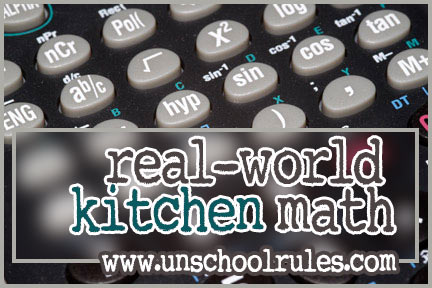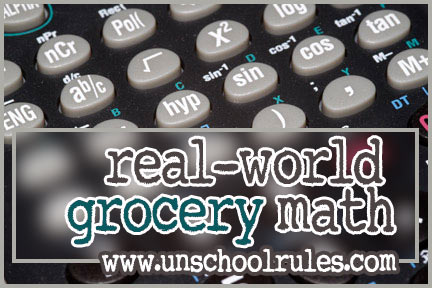I’ve got a bachelor’s degree in advanced math, and a 12-year-old daughter who hates anything to do with the subject.
I’m an unschooling mama who loves to do math puzzles and logic problems for fun.
I’m not sure if that combination makes me an expert or just crazy, but because of it, I agreed to take part in the iHomeschool Network’s “5 days of…” series this week with a look at 5 days of real-world math.
Today, we’ll look at three types of math you need in your kitchen.
Fractions galore: Measuring cups, recipe adaptations and serving sizes
In some ways, this is the most straightforward “kitchen math” most people do – multiplying and dividing and dealing with fractions.
Take measuring cups. If you’ve just dirtied the half-cup measure with oil and you need another half-cup of flour, you can fill your quarter-cup measure twice. Most of us do this without even thinking, but it’s an important skill to talk about with your family.
My daughter is an incredible example of this. She had no idea as of six month ago that two fourths were the same as one half. Or, if she did in theory, she had no idea that it worked when cooking!
The same is true for adapting recipes by halving or doubling. If a recipe calls for four eggs to make 10 of something, and you only want to make 5, most of us know that we use half the quantity of each ingredient to make half as much. But again, for some people, the idea that halving each part makes half of the whole is fine in concept but not in practice – or vice versa; we can do it, but we don’t understand how it works!
Serving sizes are another case of “kitchen multiplication.” If my can of tuna says it has 2.5 servings in it, and each serving has 90 calories, but I eat the whole can (because, uh, doesn’t everyone?), I need to know that I’m having two 90-calorie servings and one half-of-90-calorie, or 45-calorie, serving, making 225 calories.
Where to start: I highly encourage the use of measuring cups as toys. Please don’t make your children sit down and pour things to make a cup or a half-cup or a third-cup or whatever. Give them a big box of rice and a bunch of measuring cups, and they’ll figure it out for themselves. Honest. Trust your kids.
Halving and doubling recipes is another great “lesson” in real-world math. But before you can do that, your children have to understand how to read a recipe, including how to tell how much of the food you’ll have as the finished product.
Once you’ve covered those basics, pick something they REALLY like – like cookies – and work with them to make twice as many as a treat. You’ll have more-than-willing math helpers then!
Time and temperature: Manning (or womanning?) the oven
I watched an episode of Phineas and Ferb last week in which, while the main female character was cooking in a hurry, she realized she didn’t have three hours to cook something at 450 degrees. So, her friend figured, they could just cook it for 5 minutes at 16,200 degrees – she called it “simple math!”
Even my math-loathing daughter was able to see that for the fallacy it was!
Cooking is a great chance to make sure you really understand time and temperature.
First of all, if you put your favorite frozen meal in the microwave for the 5 minutes and 30 seconds it says on the package and it’s a melted, dry heap, you have to know to cook it less the next time. But if you go too far and cook it for 3 minutes and 30 seconds and the middle is cold, then you know you have to go back the other direction!
That’s intuitive for some people – but not everyone.
The same goes with temperature. If you put a pizza in your oven and the middle is still cold while the crust is burnt, you have to understand that your temperature is too high.
That’s hard to “get” – part of it’s cold; how can it be too hot, right?
You really have to understand how heat works – and that a lower temperature, consistently over time, can make something more “cooked” than a higher temperature inconsistently or for a short period!
Where to start: Get your kids used to using the stove or the microwave. Have them set timers – gosh, my daughter loves to set a timer – and see how long it takes water to boil in different-sized pans.
Have them experiment with making their favorite microwaved food using 30-second intervals around the suggested cooking time on the package (say, 4 minutes, 4 minutes 30 seconds and 5 minutes, or something like that) and see which way they like it best.
The more practical experience you have with cooking times and temperatures, the more you’ll intuitively be able to adapt. Because I don’t bake much, I still have to really think about how to make my cookies come out the way I want. But man, I can time my various pots on top of the stove to boil at the same time like nobody’s business!
Unit conversions: Quarts, liters, gallons, cups, teaspoons and all that jazz
I don’t know about you, but I do not have the faintest idea off the top of my head how many pints equal a gallon, or how many tablespoons make a cup, and whether that whole wet-or-dry-measure thing factors in and how.
That said, I know that I don’t know – so I make sure that I’m reading recipes carefully and using measuring cups marked appropriately if at all possible. (I threw out the measuring cup that was only in metric some time ago!) And when I don’t know, I look it up.
The hardest thing about recipe units is that it’s SO easy to get confused, and especially with baking, a small difference can have a large effect on the final product!
Where to start: Hang on to this website of equivalents and measures from Exploratorium’s The Accidental Scientist. Print it, laminate it, give a copy to your kids when they move out. That and a good 5-ingredient cookbook will take you far in the kitchen!
This is one of those things that, if you do it often enough, you’ll probably start to remember. I did finally learn that three teaspoons is a tablespoon, for instance.
The best thing here is, if you have young children, or older children who are just beginning to cook, talk to them about the many different units of measure. I bet there’s nothing you do day-to-day that involves more DIFFERENT measurements than cooking. And if you aren’t expecting it, it can get confusing real quick!
Knowing the conversions isn’t the biggest deal – you can look that up. But understanding in which cases you will need to look something up is what really matters.
The rest of the series
Sunday: When numbers matter: A look at math in the real world (introduction)
Monday: The math you need at the grocery store
Today: The math you need in your kitchen
Wednesday: The math you need to manage your money
Thursday: The math you need to play sports and do other fun stuff (yes, really!)
Friday: Real-world math resources you’ll love
More five-day fun
This post is part of the iHomeschool Network’s summer “Five Days Of…” series. Click the collage below to see how some of my fellow bloggers are spending their “five days,” and to learn more about our series sponsor, the BEECH Retreat bloggers’ conference!




